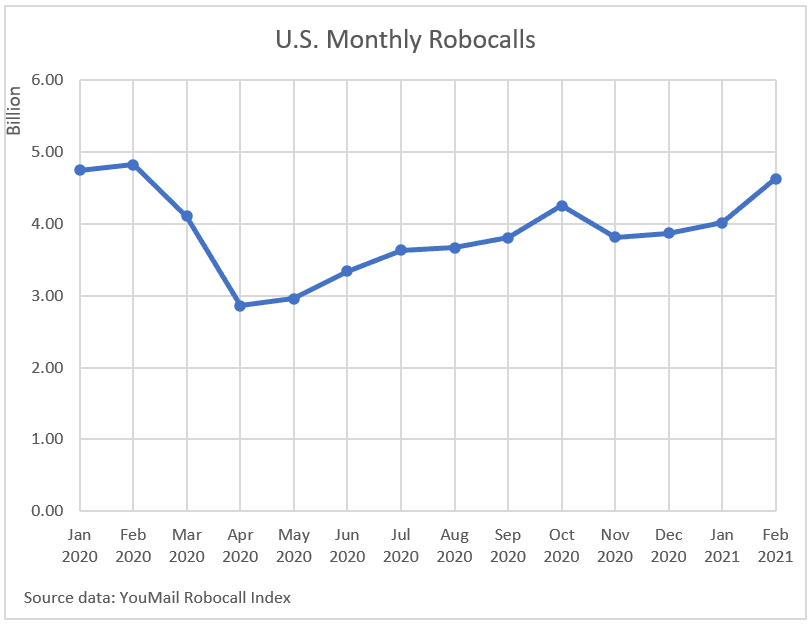Robocalls are back
Robocall activity plummeted during the first pandemic wave of March–April 2020. Since then, robocalls have been gradually increasing each month and have returned to pre-pandemic levels, despite increased use of robocall prevention measures. Let’s take a closer look.

Monthly robocalls peaked during 2020 at 4.8 billion in February. During March and April, monthly robocall volume dropped 41%, to just under 3 billion per month. CNN reported that the decline included both scam and legitimate robocalls:
The decline coincides with the shuttering of call centers in countries such as India, Pakistan and the Philippines, where workers who are placing unwanted robocalls don’t own laptops to support working from home and some have lost their jobs or been furloughed.
Since April 2020, monthly robocalls have been increasing an average of about 5% per month. Anecdotally we’ve heard about, and experienced for ourselves, an increase in spam robocalls, especially during February 2021.
Robocalls are back.

Robocall prevention actions in 2020
How did this happen? It seems like there was considerable effort to prevent illegal robocalls during this time:
- The FCC and FTC asked international gateway providers in February 2020, April 2020, and again in May 2020 to block scam robocalls from reaching U.S. consumers. This signaled a heightened level of scrutiny and enforcement from government regulators.
- In May 2020, the FCC announced that it will no longer warn illegal robocallers before issuing penalties.
- In June 2020 the FCC announced a $225 million fine against two Texas-based robocallers.
- In June 2020, the FCC issued a staff report on robocall blocking that touted widespread availability of robocall blocking services from voice service providers. Some providers initiated opt-out blocking by default. Many providers reported blocking millions of calls.
- In July 2020, the FCC approved robocall blocking rules that provide safe harbor to protect voice service providers from liability if they inadvertently block wanted calls. These rules were published in the Federal Register in September 2020 and became effective in October 2020.
- In July 2020, The FCC designated the Industry Traceback Group as the Registered Traceback Consortium.
- In September 2020, the FTC and State of Ohio invoked a $2.1 million settlement against a VoIP service provider for bringing illegal robocalls into the U.S.
- In October 2020, The FCC fined an Arizona-based telemarketer $37.5 million for illegal robocalls.
- In October 2020, The FCC issued a report and order on one-ring (Wangiri) scam calls. The order explicitly enables voice service providers to block calls from telephone numbers that are highly likely to be associated with one-ring scams. The order also extended safe harbor for blocking such calls.
- In February 2021, the Industry Traceback Group, which is the designated Robocall Traceback Consortium, reported on the progress made in 2020 in tracing illegal robocalls.
- Approximately 215 tracebacks per month, up 115% from 2019 and 975% from 2018
- Received 75 subpoenas/civil investigation demands, up 275% from 2019
- Supported nearly a dozen enforcement actions target nearly 50 individuals and entities
- Average time to complete a traceback was approximately four days, down 50% from 2019
- On December 30, 2020, the FCC issued a report and order that requires voice service providers to participate in traceback.
Why are robocalls still increasing?
Money. Illegal robocalls are typically trying to sell something or swindle their victims using some sort of scam. The combination of financial motive and lack of effective mitigation, despite increased efforts, means that illegal robocalls are still with us, and growing.
TransNexus has a comprehensive suite of robocall mitigation solutions to prevent the origination of unlawful robocalls.
Learn more about robocall mitigationRobocall prevention in 2021
There are more robocall prevention initiatives coming in 2021:
- All voice service providers that originate calls with U.S. NANP calling numbers must perform STIR/SHAKEN call authentication by June 30, 2021.
- Exemptions are available for some categories of calls and service providers. However, any provider exercising an exemption must perform robocall mitigation on calls that they originate. Such providers must also describe their Robocall Mitigation Plan in a certification they will file with the FCC.
- Notice that this robocall mitigation requirement applies at origination, not termination. Many terminating service providers offer robocall prevention, but that doesn’t count for the new robocall mitigation mandate.
- All voice service providers that originate, transit, or terminate calls with U.S. NANP calling numbers must file a Robocall Mitigation Certification with the FCC by June 30, 2021.
- Voice service providers must refuse to accept calls with U.S. NANP calling numbers from originating or intermediate providers that do not have a Robocall Mitigation Certification on file.
Will new measures be sufficient?
The legislators who drafted the TRACED Act, and regulators that enforce it, certainly believe that call authentication and robocall blocking safe harbor will be sufficient to curb illegal robocalls.
However, there is a widely held belief in the industry that call authentication is necessary but not sufficient to reduce illegal robocalls. We agree with this view, for the following reasons:
- STIR/SHAKEN call authentication only tells the terminating provider that the calling number is not spoofed. It does not identify bad calls, nor is it intended to do that.
- Call analytics can identify suspicious calls—those calls likely to be robocalls. However, call analytics doesn’t work as well when the calling number is spoofed, especially neighbor-spoofed legitimate numbers. (There is an innovative technique to identify neighbor spoofing, but it is not available in all call scenarios.)
- Call authentication and call analytics are powerfully effective when used together. It should be both, not either/or.
The TRACED Act and regulations that enforce it require call authentication. Robocall mitigation is only required for use on origination of calls that are not authenticated with STIR/SHAKEN.
Several commentators have urged the FCC to require both call authentication and robocall mitigation, but the Commission has not done so, because the TRACED Act does not instruct them to issue such a rule.
Perhaps customer complaints will pressure voice service providers to perform call authentication and robocall mitigation at origination, and robocall prevention at termination on all calls. The regulations allow this, but do not require it.
TransNexus solutions
We offer STIR/SHAKEN and robocall prevention solutions in our ClearIP and NexOSS software platforms.
In addition, we help service providers with all aspects of STIR/SHAKEN deployment, including registering with the Policy Administrator and filing their Robocall Mitigation certification with the FCC.
Contact us today to learn more.
Our STIR/SHAKEN products:
- Work with your existing network
- Support SIP and TDM
- Affordable, easy to deploy